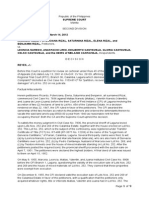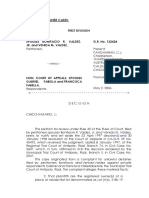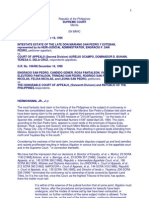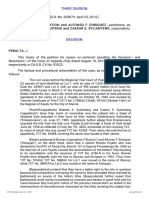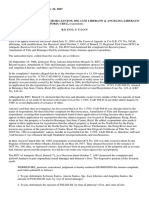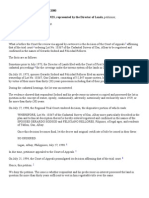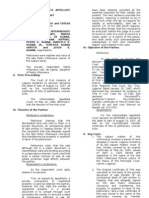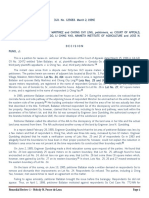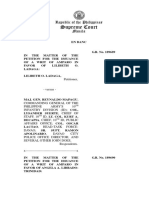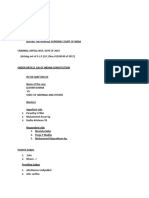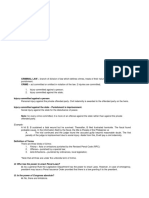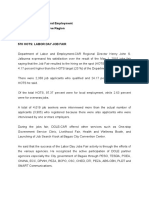Rizal Vs Naredo
Rizal Vs Naredo
Uploaded by
Melo Ponce de LeonCopyright:
Rizal Vs Naredo
Rizal Vs Naredo
Uploaded by
Melo Ponce de LeonOriginal Description:
Original Title
Copyright
Share this document
Did you find this document useful?
Is this content inappropriate?
Copyright:
Rizal Vs Naredo
Rizal Vs Naredo
Uploaded by
Melo Ponce de LeonCopyright:
SECOND DIVISION
RICARDO RIZAL, POTENCIANA G.R. No. 151898
RIZAL, SATURNINA RIZAL, ELENA
Present:
RIZAL, and BENJAMIN RIZAL,
Petitioners,
CARPIO, J.,
- versus -
Chairperson,
BRION,
LEONCIA NAREDO, ANASTACIO
PEREZ,
LIRIO, EDILBERTO CANTAVIEJA,
SERENO, and
GLORIA CANTAVIEJA,
REYES, JJ.
CELSO CANTAVIEJA, and
the HEIRS of MELANIE CANTAVIEJA,
Promulgated:
Respondents.
March 14, 2012
x------------------------------------------------------------------------------------x
DECISION
REYES, J .:
Before this Court is a petition for review on certiorari under Rule 45 of the Decision [1] of the Court of Appeals (CA)
dated July 13, 2001 in CA-G.R. CV No. 26109, affirming the decision of the Regional Trial Court (RTC), Branch 36,
Calamba, Laguna which dismissed the Complaint, [2] docketed as Civil Case No. 1153-87-C[3] for partition, recovery of
shares with damages of Lot No. 252 on res judicata.
Factual Antecedents
Herein petitioners Ricardo, Potenciana, Elena, Saturnina and Benjamin, all surnamed Rizal, commenced Civil Case No.
7836 against Matias Naredo (Matias), Valentin Naredo (Valentin) and Juana de Leon (Juana) before the then Court of
First Instance (CFI) of Laguna involving the accretion of two (2) hectares of land to Lot No. 454 of the Calamba
Estate. In a decision rendered on May 22, 1947, the CFI ruled in favor of the petitioners. The CFI awarded the
ownership of the two-hectare accretion to the petitioners and ordered the defendants therein to vacate the said land
and to pay P500.00 a year from 1943 as reasonable rent for their occupancy thereof. Both the CA and the Supreme
Court upheld the decision.
Remedial Review 1 – Melody M. Ponce de Leon Page 1
To satisfy the money judgment in Civil Case No. 7836, the provincial sheriff of Laguna levied upon Lots
Nos. 252 and 269 of the Calamba Estate, together with the house erected on Lot No. 252. This Lot No. 252, which is
the subject of the controversy, was registered under Transfer Certificate of Title (TCT) No. RT-488 (RT-3377 No.
12206) in the name of the Legal Heirs of Gervacia Cantillano, of Parian, Calamba, Laguna. Several third-party claims
were filed, to wit: (a) by Leoncia Naredo (Leoncia) and Marcela Naredo (Marcela), who are also heirs of Gervacia
Cantillano over Lot No. 252; (b) by Pedro Cantavieja, husband of Marcela over Lot No. 269; and (c) by Teodoro
Armesto over the house of mixed materials standing on Lot No. 252. After the petitioners posted the required bond,
the provincial sheriff proceeded with the auction sale on April 7, 1951. The petitioners were declared the highest
bidders. A final deed of sale was issued to them on April 15, 1952.
On May 9, 1955, Marcela, Leoncia, Matias, Valentin, and Juana instituted Civil Case No. 9908 before the CFI
Branch 1, Laguna, questioning the validity of the execution sale of Lots Nos. 252 and 269 and the house of mixed
materials on Lot No. 252. They claimed that these properties were exempt from execution.
On December 8, 1955, the CFI declared valid the execution sale of Lots Nos. 252 and 269 of the Calamba Estate in
favor of the petitioners, with a qualification that the petitioners only acquired whatever rights, title or interests Matias,
Valentin and Juana had in Lot No. 252. The sale of the house of mixed materials in Lot No. 252 was set aside
considering that a waiver was executed by the petitioners in favor of Juana. Although the CFI ordered that the
petitioners be placed in possession of Lots Nos. 252 and 269 and Matias and Valentin be ejected therefrom, it did not
evict Marcela and Leoncia from Lot No. 252 since they were not parties to Civil Case No. 7836.[4]
After the aforesaid judgment in Civil Case No. 9908, the petitioners filed Civil Case No. 36-C against Marcela and
Leoncia for partition, accounting and recovery of possession of Lot No. 252. The parties then entered into a
Compromise Agreement whereby the parties acknowledged that they owned Lot No. 252 in common, with 3/5 thereof
as the interest of the petitioners and the other 2/5 belonging to therein defendants Marcela and Leoncia. Said
Compromise Agreement was approved by the CFI Branch VI, Laguna, in an Order dated December 1, 1971. [5] The
pertinent portions of the agreement read as follows:
5. That the plaintiffs (herein petitioners) and the defendants (herein respondents) agree that said
parcel of land (Lot 252) embraced in Transfer Certificate of Title 12206, and registered in the names of
the Legal Heirs of Gervacia Cantillano, is now owned in common and in undivided shares of TWO-
FIFTHS (2/5) for the defendants and THREE-FIFTHS (3/5) for the plaintiffs;
6. That the plaintiffs and the defendants agree that the subject parcel of land be actually partitioned
as they have so caused the survey and partition of the same per the hereto attached copy of the
pertinent subdivision survey plan, marked as Annex A hereof and made integral part of this
compromise agreement;
7. That the plaintiffs and the defendants do hereby express their unqualified conformity to the said
partition and they hereby accept to their full and entire satisfaction their respective determined shares
in the subject parcel of land, and they agree to have their respective determined portions, Two-Fifths
(2/5) for defendants and Three-Fifths (3/5) for plaintiffs, to be covered by independent and separate
certificates of title in their respective names.
8. That the plaintiffs agree to shoulder all the expenses incurred in the partition and to pay all
expenses and fees which may be entailed in the issuance of the independent certificates of title in
favor of the respective parties by the proper Registry of Deeds; [6]
Ten years after or on August 11, 1981, Marcela and Leoncia, assisted by their husbands, instituted Civil Case
No. 299-83-C assailing the Compromise Agreement. They claimed that said agreement was a forgery and that their
Remedial Review 1 – Melody M. Ponce de Leon Page 2
lawyer was not duly authorized for the purpose. In an Order dated July 6, 1984, the trial court dismissed the case
without prejudice to the plaintiffs failure to prosecute.
Thereafter, on September 26, 1984, Marcela and Leoncia instituted Civil Case No. 792-84-C, for
enforcement of judgment, partition and segregation of shares with damages over Lot No. 252. On July 6, 1985, the
trial court dismissed the complaint on the ground of prescription. No appeal was taken therefrom.
On September 21, 1987, the petitioners filed a Complaint before the RTC for the immediate segregation,
partition and recovery of shares and ownership of Lot No. 252, with damages. This was docketed as Civil Case No.
1153-87-C. However, on April 3, 1990, on the basis of the pleadings and exhibits, the court a quo dismissed the
complaint because of res judicata. The trial court stated thus:
A perusal of this instant case and Civil Case No. 792-84-C, (Exh. 1) will readily show that between
these causes of actions, there are (a) identity of parties; (b) identity of subject matter; and (c) identity
of cause of action. As admitted by the parties, the judgment in Civil Case No. 792-84-C is now final
and executory. While there may appear a difference in the forms of action, the same is irrelevant for
purposes of determining res judicata. It is a firmly established rule that a different remedy sought or a
diverse form of action does not prevent the estoppel of the formeradjudication.
x x x.[7]
lousy
Aggrieved, the petitioners appealed to the CA, docketed as CA-G.R. CV No. 26109. Unfortunately, the original records
of the case were misplaced. After earnest efforts were made for the reconstitution of the records of the case, the
parties agreed to have the case submitted for decision based on the documents submitted. [8]
In the now assailed decision, [9] the CA dismissed the appeal. The CA found that the appellants brief neither contained
the required page references to the records, as provided in Section 13 of Rule 44 of the Rules of Court; nor was it
specified, both in the prayer and in the body of the complaint, the specific amounts of the petitioners claim for actual,
moral, exemplary and compensatory damages, as enunciated in Manchester Development Corporation v. Court of
Appeals.[10]
As to the substantive issues raised in the complaint, the CA ruled that the action for partition has been barred
by res judicata. It also held that the petitioners no longer had any cause of action for partition because the co-
ownership of the parties over Lot No. 252 had ceased to exist by the Order of the CFI Branch VI, Laguna on December
1, 1971.
Issues
In the case at bar, the petitioners submit the following issues for this Courts consideration, to wit:
A.
THE CA ERRED IN DISMISSING THE APPEAL ON THE GROUND THAT THE PETITIONERS' APPEAL BRIEF
FAILED TO MAKE PAGE REFERENCES TO THE RECORD.
B.
THE CA ERRED IN APPLYING THE RULING IN THE MANCHESTER CASE REGARDING DOCKET FEES.
C.
Remedial Review 1 – Melody M. Ponce de Leon Page 3
THE CA ERRED IN DISMISSING THE APPEAL ON THE GROUND OF PRESCRIPTION AND RES JUDICATA.
D.
THE RTC ERRED IN DISMISSING THE ENTIRE CASE.[11]
Ruling and Discussions
We find no merit in the petition.
Failure to observe the requirements under Section 13(a), Rule 44
of the 1997 Rules of Court and to pay the correct docket fees is
fatal to the appeal.
The petitioners argue that the CA erred in dismissing their appeal for their failure to indicate the page references to
the records of the case pursuant to Section 13(a), Rule 44 [12]of the Rules of Court. They invoke Section 6, Rule 1 of
the 1997 Rules of Civil Procedure which states that technical rules shall
be liberally construed in order to promote a just, speedy and inexpensive disposition of every action and
proceeding. They cite the case of Pacific Life Assurance Corporation v. Sison ,[13] where it was held that an appeal
should not be dismissed on mere technicality.
It is settled that technical rules of procedure are mere tools designed to facilitate the attainment of justice. Their strict
and rigid application should be relaxed when they hinder rather than promote substantial justice. Cases should as
much as possible be resolved on the merits, and not on mere technicalities. The failure of the petitioners' appeal brief
to contain page references to the records is a formal defect which may be considered as minor, if not negligible. [14]
However, while this Court may be lenient in some instances on formal defects of pleadings filed with the court, it could
not close its eyes when a litigant continuously ignores technical rules, to the point of wanton disregard of the rationale
behind those rules. In fact, this Court has consistently affirmed the importance of complying with the requirements in
Section 13(a), Rule 44[15] of the Rules of Court in many of its decisions, particularly in Mendoza v. United Coconut
Planters Bank, Inc.,[16] where the Court explicitly stated that:
Rule 44 and 50 of the 1997 Rules of Civil Procedure are designed for the proper and prompt
disposition of cases before the Court of Appeals Rules of Procedure exist for a noble purpose, and to
disregard such rules in the guise of liberal construction would be to defeat such purpose. The Court of
Appeals noted in its Resolution denying petitioners motion for reconsideration that despite ample
opportunity, petitioners never attempted to file an amended appellants brief correcting the
deficiencies of their brief, but obstinately clung to their argument that their Appellants Brief
substantially complied with the rules. Such obstinacy is incongruous with their plea for liberality in
construing the rules on appeal.
De Liano v. Court of Appeals held:
Some may argue that adherence to these formal requirements serves but a meaningless purpose, that
these may be ignored with little risk in the smug certainty that liberality in the application of procedural
rules can always be relied upon to remedy the infirmities. This misses the point. We are not martinets;
in appropriate instances, we are prepared to listen to reason, and to give relief as the circumstances
may warrant. However, when the error relates to something so elementary as to be inexcusable, our
Remedial Review 1 – Melody M. Ponce de Leon Page 4
discretion becomes nothing more than an exercise in frustration. It comes as an unpleasant shock to
us that the contents of an appellants brief should still be raised as an issue now. There is nothing
arcane or novel about the provisions of Section 13, Rule 44.The rule governing the contents of
appellants briefs has existed since the old Rules of Court, which took effect on July 1, 1940, as well as
the Revised Rules of Court, which took effect on January 1, 1964, until they were superseded by the
present 1997 Rules of Civil Procedure. The provisions were substantially preserved, with few revisions.
[17]
Moreover, the petitioners also failed to pay the correct docket fees; in which case, jurisdiction did not vest in the trial
court. In Siapno v. Manalo,[18] this Court has made it abundantly clear that any complaint, petition, answer and other
similar pleading, which does not specify both in its body and prayer the amount of damages being claimed, should not
be accepted or admitted, or should be expunged from the records, as may be the case. [19]
The petitioners alleged in their complaint in Civil Case No. 1153-87-C [20] that they suffered actual loss from the time
they had been deprived of their share of 3/5 on Lot No. 252 by the respondents, as well as moral and exemplary
damages, attorney's fees and litigation expenses. However, the only claims they specified in their prayer were for the
attorney's fees in the amount of P30,000.00 and P500.00 for every court appearance of the counsel.
In Siapno,[21] the complaint alleged in its body the aggregate sum of P4,500,000 in moral and exemplary
damages and attorney's fees, but the prayer portion did not mention these claims, nor did it even pray for the
payment of damages. This Court held that such a complaint should be dismissed outright; or if already admitted,
should be expunged from the records. The Court explained that the rule requiring the amount of damages claimed to
be specified not only in the body of the pleading but also in its prayer portion was intended to put an end to the then
prevailing practice of lawyers where the damages prayed for were recited only in the body of the complaint, but not in
the prayer, in order to evade payment of the correct filing fees. As held by the Court in Manchester:[22]
To put a stop to this irregularity, henceforth all complaints, petitions, answers and other similar
pleadings should specify the amount of damages being prayed for not only in the body of the pleading
but also in the prayer, and said damages shall be considered in the assessment of the filing fees in
any case. Any pleading that fails to comply with this requirement shall not be accepted nor admitted,
or shall otherwise be expunged from the record.[23]
In Sun Insurance Office Ltd. v. Judge Asuncion,[24] the Court laid down the following rules as regards the payment of
filing fees:
1. It is not simply the filing of the complaint or appropriate initiatory
pleading, but the payment of the prescribed docket fee that vests a trial court with jurisdiction over the
subject matter or nature of the action. Where the filing of the initiatory pleading is not accompanied
by payment of the docket fee, the court may allow payment of the fee within a reasonable time but in
no case beyond the applicable prescriptive or reglementary period.
2. The same rule applies to permissive counterclaims, third-party claims
and similar pleadings, which shall not be considered filed until and unless the filing fee prescribed
therefor is paid. The court may also allow payment of said fee within a reasonable time but also in no
case beyond its applicable prescriptive or reglementary period.
3. Where the trial court acquires jurisdiction over a claim by the filing of the
appropriate pleading and payment of the prescribed filing fee but, subsequently, the judgment awards
a claim not specified in the pleading, or if specified the same has been left for determination by the
court, the additional filing fee therefor shall constitute a lien on the judgment. It shall be the
Remedial Review 1 – Melody M. Ponce de Leon Page 5
responsibility of the Clerk of Court or his duly authorized deputy to enforce said lien and assess and
collect the additional fee.[25]
It cannot be gainsaid from the above guidelines that, with the exception of pauper litigants, [26] without the payment of
the correct docket or filing fees within the reglementary period, jurisdiction over the subject-matter or nature of the
action will not vest in the trial court. In fact, a pauper litigant may still have to pay the docket fees later, by way of a
lien on the monetary or property judgment that may accrue to him. Clearly, the flexibility or liberality of the rules
sought by the petitioners cannot apply in the instant case.
Action is dismissible for res judicata and lack of cause of
action.
The petitioners vehemently deny that the partition of Lot No. 252 has already been settled in Civil Case No. 36-
C. They insist that the mere determination of the proportionate shares of the parties, as well as their respective
portions of the aforesaid lot in the Compromise Agreement is not enough. They allege that Lot No. 252 is still covered
by the old title, TCT No. 12206, in the name of the heirs of Gervacia Cantillano. The finality of the decision in Civil
Case No. 36-C did not cause Lot No. 252 to divide itself in accordance with the subdivision plan. They assert that
there must be an actual and exclusive possession of their respective portions in the plan and titles issued to each of
them accordingly.[27]
The petitioners contentions are untenable.
Article 484 of the New Civil Code provides that there is co-ownership whenever the ownership of an undivided
thing or right belongs to different persons. Thus, on the one hand, a co-owner of an undivided parcel of land is an
owner of the whole, and over the whole he exercises the right of dominion, but he is at the same time the owner of a
portion which is truly abstract. On the other hand, there is no co-ownership when the different portions owned by
different people are already concretely determined and separately identifiable, even if not yet technically described. [28]
Pursuant to Article 494 of the Civil Code, no co-owner is obliged to remain in the co-ownership, and his proper remedy
is an action for partition under Rule 69 of the Rules of Court, which he may bring at anytime in so far as his share is
concerned. Article 1079 of the Civil Code defines partition as the separation, division and assignment of a thing held
in common among those to whom it may belong. It has been held that the fact that the agreement of partition lacks
the technical description of the parties' respective portions or that the subject property was then still embraced by the
same certificate of title could not legally prevent a partition, where the different portions allotted to each were
determined and became separately identifiable.[29]
The partition of Lot No. 252 was the result of the approved Compromise Agreement in Civil Case No. 36-C, which was
immediately final and executory. Absent any showing that said Compromise Agreement was vitiated by fraud, mistake
or duress, the court cannot set aside a judgment based on compromise. [30] It is axiomatic that a compromise
agreement once approved by the court settles the rights of the parties and has the force of res judicata. It cannot be
disturbed except on the ground of vice of consent or forgery.[31]
Of equal significance is the fact that the compromise judgment in Civil Case No. 36-C settled as well the
question of which specific portions of Lot No. 252 accrued to the parties separately as their proportionate shares
therein. Through their subdivision survey plan, marked as Annex A[32] of the Compromise Agreement and made an
integral part thereof, the parties segregated and separately assigned to themselves distinct portions of Lot No.
252. The partition was immediately executory,[33] having been accomplished and completed on December 1,
1971 when judgment was rendered approving the same. The CA was correct when it stated that no co-ownership
Remedial Review 1 – Melody M. Ponce de Leon Page 6
exist when the different portions owned by different people are already concretely determined and separately
identifiable, even if not yet technically described.[34]
It bears to note that the parties even acknowledged in Paragraph 7 of the Compromise Agreement that they
had accepted their respective determined shares in the subject parcel of land, and they agree to have their
respective determined portions, Two-Fifths (2/5) for defendants and Three-Fifths (3/5) for plaintiffs, to be covered by
independent and separate certificates of title in their respective names.[35]
The petitioners slept on their rights under the partition
agreement.
To recall, the petitioners obtained part ownership of Lot No. 252 as the highest bidders at the execution sale of Lots
Nos. 252 and 269 in Civil Case No. 7836, whereas respondents Marcela and Leoncia as heirs of Gervacia Cantillano
retained their 2/5 interest in Lot No. 252 since they were not impleaded in the said case. As buyers of land, the
petitioners had the right to pursue their share therein all the way to the issuance of their separate title and recovery of
possession of their portion, beginning with the filing of Civil Case No. 36-C.
Concerning the registration with the Registry of Deeds of a judgment of partition of land, Section 81 of
Presidential Decree (P.D.) No. 1529 provides that after the entry of the final judgment of partition, a copy of such final
judgment shall be filed and registered. If the land is set off to the owner in severalty, each owner shall be entitled to
have his certificate entered showing the share set off to him in severalty, and to receive an owner's duplicate thereof.
[36]
Accordingly, Paragraph 8 of the Compromise Agreement
provided that the petitioners shall shoulder all the expenses incurred in the partition and to pay all expenses and fees
which may be incurred in the issuance of the independent certificates of title in favor of the respective parties by the
proper Registry of Deeds.[37] Unfortunately, the records do not disclose that the petitioners neither filed and registered
with the Register of Deeds a certified copy of the final judgment of partition in Civil Case No. 36-C, nor did
they perform or cause to be performed all further acts requisite for the cancellation of TCT No. 12206 and the
issuance of the parties' separate titles over their assigned portions in Lot No. 252. The only entry in TCT No. 12206,
[38]
prior to the recording on June 13, 1979 of the issuance to the petitioners of a second duplicate copy of TCT No.
12206, is the annotation in April 1952 of the execution sale of Lot No. 252 to the petitioners.
Section 6, Rule 39 of the Rules of Court provides:
Sec. 6. Execution by motion or by independent action . A final and executory judgment or order may
be executed on motion within five
(5) years from the date of its entry. After the lapse of such time, and before it is barred by the statute
of limitations, a judgment may be
enforced by action. The revived judgment may also be enforced by motion within five (5) years from
the date of its entry and thereafter by action before it is barred by the statute of limitations.
A final and executory judgment may be executed by the prevailing party as a matter of right by mere motion within
five (5) years from the entry of judgment, failing which the judgment is reduced to a mere right of action which must
be enforced by the institution of a complaint in a regular court within ten (10) years from finality of the judgment.[39]In
the instant case, there is no showing that after the judgment in Civil Case No. 36-C, the petitioners filed a motion to
execute the same during the first five (5) years after its finality, or within the succeeding five (5) years, by a
civil action to revive the judgment, before it would have been barred by the statute of limitations. [40] An action
for revival of judgment is governed by Articles 1144(3) and 1152 of the Civil Code, and Section 6, Rule 39 of the Rules
of Court. Articles 1144(3) and 1152 of the Code state:
Remedial Review 1 – Melody M. Ponce de Leon Page 7
Art. 1144. The following actions must be brought within ten years from the time the right of action
accrues:
xxxx
(3) Upon a judgment
Art. 1152. The period for prescription of actions to demand the fulfillment of obligations declared by
a judgment commences from the time the judgment became final.
When the petitioners filed Civil Case No. 1153-87-C on September 21, 1987, it was not purportedly to revive the
judgment in Civil Case No. 36-C. It was apparently an action for Partition, Recovery of Shares with Damages, but
nonetheless citing as basis of the Compromise Agreement in Civil Case No. 36-C. The petitioners wanted to
accomplish through an entirely new action what was already adjudicated in Civil Case No. 36-C, rendered 17 years
earlier, but which they inexplicably failed to enforce. The petitioners do not allege that they tried to execute the
compromise judgment in Civil Case No. 36-C either by motion or by action to revive judgment within the prescriptive
period. Absent any proof that the respondents resorted to dilatory schemes and maneuvers to prevent the execution
of the Compromise Agreement, [41] and contrary to the petitioners gratuitous assertion in paragraph VIII of their
complaint in Civil Case No. 1153-87-C, we fail to see how the mere filing by the respondents of Civil Case No. 299-83-
C on August 11, 1981 could have in any way prevented or impeded the petitioners from executing the judgment in
Civil Case No. 36-C.
We thus sustain the respondents' affirmative defenses of res judicata and lack of cause of action, and uphold the
appellate and trial courts' rejection of the petitioners' ostensible attempt to revive the already stale judgment in Civil
Case No. 36-C through an entirely new action for partition. The Court agrees with the CA when it explained:
a. The judgment that effected res judicata is not so much the dismissal of the case due to
prescription in Civil Case No. 792-84-C. What more appropriately leads to res judicata to this
case is the final Compromise Judgment in Civil Case No. 36-C. All the elements of res
judicata are present, a final decision on the merits, between the same parties, on the same subject
matter and cause of action. x x x.
b. The present complaint states no cause of action. There is no doubt that appellants prayer for
partition is anchored on their supposed co-ownership of Lot No. 252 plus the added fact that it is
still covered by Transfer Certificate of Title No. 12206. However, appellants must have lost track of
the fact that at the time the present action was commenced, partition was no longer an available
remedy in their favor simply because their pretended co-ownership had already ceased to
exist. Their 3/5 shares had already been segregated and determined in the subdivision plan
mentioned in the Compromise Judgment and have, in fact, accepted their share to their
satisfaction. In De la Cruz vs. Cruz, 32 SCRA 307 [1970], the Supreme Court, through Justice J.B.L.
Reyes, said that co-ownership no longer exists over the whole parcel of land where the portions
owned by the parties are already determined and identifiable. That said respective portions are
not technically described, or that said portions are still embraced in one and the same certificate
of title, does not make said portions less determinable, or identifiable, or distinguishable, one from
the other, nor that dominion over its portions rest exclusively in their respective owners. [42]
Remedial Review 1 – Melody M. Ponce de Leon Page 8
Nonetheless, it must be made clear that nothing in this decision shall be understood to mean that the petitioners have
lost their title or interest in the subject property. The final (definite) deed of sale executed by the sheriff in favor of the
petitioners pursuant to the execution sale in Civil Case No. 7836, which was duly registered in TCT No. 12206 on April
15, 1952, constituted an effective conveyance to the petitioners of the property sold therein and entitled them to
possession thereof,[43] although in the subsequent decision in 1955 in Civil Case No. 9908, the respondents 2/5
interest in the property was recognized, thereby amending the extent of the petitioners title. The said judgment has
not been registered, and neither was the compromise judgment of partition in Civil Case No. 36-C dated December 1,
1971, which established the parties respective specific portions in Lot No. 252. Thus, as a prerequisite to the issuance
of a new title in the name of the petitioners over their 3/5 allocated portion, we believe that Section 81 [44] of P.D. No.
1529 does not bar the belated registration of the compromise judgment in Civil Case No. 36-C.
WHEREFORE, premises considered, the petition is DENIED. The Decision of the Court of Appeals dated July
13, 2001 in CA-G.R. CV No. 26109 is AFFIRMED.
SO ORDERED.
Remedial Review 1 – Melody M. Ponce de Leon Page 9
You might also like
- Discussion in Affirmative DefensesDocument10 pagesDiscussion in Affirmative Defensesjennifer yantoNo ratings yet
- Seriña v. CaballeroDocument9 pagesSeriña v. Caballeronewin12No ratings yet
- Rizal Vs NaredoDocument9 pagesRizal Vs NaredodonnyNo ratings yet
- B. F. Rizal - v. - Naredo PDFDocument11 pagesB. F. Rizal - v. - Naredo PDFAmmie AsturiasNo ratings yet
- Agrarian Law Reform Full CasesDocument10 pagesAgrarian Law Reform Full CasesRitch RepatoNo ratings yet
- Third Division Skunac Corporation Alfonso F. Enriquez, and G.R. No. 205879Document15 pagesThird Division Skunac Corporation Alfonso F. Enriquez, and G.R. No. 205879Monocrete Construction Philippines, Inc.No ratings yet
- Unlawful Detainer CasesDocument49 pagesUnlawful Detainer CasesRiza Mae OmegaNo ratings yet
- Sta. Ana V CarpoDocument10 pagesSta. Ana V Carpo5j269c9w49No ratings yet
- 4 Sepe v. Heirs of AnastaciaDocument9 pages4 Sepe v. Heirs of Anastaciajoselle torrechillaNo ratings yet
- 519 SCRA 79 Tating Vs MarcellaDocument9 pages519 SCRA 79 Tating Vs MarcellaMarifel LagareNo ratings yet
- G.R. No. 155208: Custom SearchDocument6 pagesG.R. No. 155208: Custom SearchemslansanganNo ratings yet
- Ambray Vs Tsourous, Et AlDocument6 pagesAmbray Vs Tsourous, Et AlAraveug InnavoigNo ratings yet
- #25 Agra Case - Rivera Vs Del RosarioDocument12 pages#25 Agra Case - Rivera Vs Del RosarioAvilopezNo ratings yet
- G.R. No. 103727Document21 pagesG.R. No. 103727BLP CooperativeNo ratings yet
- Supreme Court: Republic of The PhilippinesDocument12 pagesSupreme Court: Republic of The Philippinesecinue guirreisaNo ratings yet
- Remediadl Law Oct. 14 CasesDocument114 pagesRemediadl Law Oct. 14 CasesAudrey Michelle C. KwanNo ratings yet
- Tating Vs MarcellaDocument5 pagesTating Vs MarcellaAnatheaAcabanNo ratings yet
- 1144 - Brito, SR Vs DianalaDocument7 pages1144 - Brito, SR Vs DianalaDayle ManlodNo ratings yet
- Petitioners Vs Vs Respondents: Third DivisionDocument11 pagesPetitioners Vs Vs Respondents: Third DivisionMilane Anne CunananNo ratings yet
- Valderrama Vs ArguelesDocument18 pagesValderrama Vs ArguelesJanMikhailPanerioNo ratings yet
- Supreme Court Manila: Republic of The PhilippinesDocument15 pagesSupreme Court Manila: Republic of The PhilippinesheyoooNo ratings yet
- Serna v. Dele Cruz, G.R. No. 237291, Feb. 1, 2021 (Admission in Pleadings)Document7 pagesSerna v. Dele Cruz, G.R. No. 237291, Feb. 1, 2021 (Admission in Pleadings)Aisaia Jay ToralNo ratings yet
- Hrs of Mariano Vs City of NagaDocument14 pagesHrs of Mariano Vs City of NagaELMER JONATHAN ORBITA100% (1)
- Spouses Narciso Rongavilla and Dolores Rongavilla Petitioners, vs. Court of Appeals and Mercedes Dela Cruz and Florencia Dela Cruz, RespondentsDocument8 pagesSpouses Narciso Rongavilla and Dolores Rongavilla Petitioners, vs. Court of Appeals and Mercedes Dela Cruz and Florencia Dela Cruz, RespondentsJudy Miraflores DumdumaNo ratings yet
- Heirs of Natividad v. Mauricio NatividadDocument8 pagesHeirs of Natividad v. Mauricio NatividadApa MendozaNo ratings yet
- Supreme Court: Republic of The PhilippinesDocument14 pagesSupreme Court: Republic of The PhilippinesChristian Mark ValenciaNo ratings yet
- Antonio Vs SantosDocument3 pagesAntonio Vs SantosRengie GaloNo ratings yet
- Rongavilla V CADocument8 pagesRongavilla V CAitsmestephNo ratings yet
- Mendez v. EugeniaDocument6 pagesMendez v. EugeniaAnonChieNo ratings yet
- Torres v. Satsatin. G.R. No. 166759, 25 November 2009Document11 pagesTorres v. Satsatin. G.R. No. 166759, 25 November 2009Mary ruth DavidNo ratings yet
- Sales Par 6 2Document90 pagesSales Par 6 2NC BergoniaNo ratings yet
- Vda de Reyes Vs CADocument9 pagesVda de Reyes Vs CAkarl doceoNo ratings yet
- Upreme Tourt: L/epublic of Tbe LlbilippineDocument10 pagesUpreme Tourt: L/epublic of Tbe LlbilippineMonocrete Construction Philippines, Inc.No ratings yet
- Coronado v. CA, G.R. No. 78778, December 3, 1990 (191 SCRA 894)Document7 pagesCoronado v. CA, G.R. No. 78778, December 3, 1990 (191 SCRA 894)ryanmeinNo ratings yet
- Land Title Cases IIDocument12 pagesLand Title Cases IICatherine Joy CataminNo ratings yet
- Spouses Ismael and Teresita Macasaet Vs Spouses Vicente and Rosario MacasaetDocument20 pagesSpouses Ismael and Teresita Macasaet Vs Spouses Vicente and Rosario MacasaetGladys Laureta GarciaNo ratings yet
- Quiz 2 09 19Document13 pagesQuiz 2 09 19Rey Jay BicarNo ratings yet
- LTD Cases 08-10Document42 pagesLTD Cases 08-10Rich Lopez AlmarioNo ratings yet
- Sajonas v. CA 258 SCRA 79 July 5 1996Document10 pagesSajonas v. CA 258 SCRA 79 July 5 1996idko2wNo ratings yet
- Sps Pascual Vs Sps BallesterosDocument7 pagesSps Pascual Vs Sps BallesterosJustin Jomel ConsultaNo ratings yet
- Quintos v. NicolasDocument10 pagesQuintos v. NicolasPearl Ponce de LeonNo ratings yet
- 29 - Sps. Garcia V GarciaDocument4 pages29 - Sps. Garcia V GarciaMarione ThiamNo ratings yet
- Rivera-Pascual Vs LimDocument9 pagesRivera-Pascual Vs LimMelo Ponce de LeonNo ratings yet
- 3L/Epuhlic of Tbe: QcourtDocument12 pages3L/Epuhlic of Tbe: QcourtJanMikhailPanerioNo ratings yet
- Reconstitution of Title CasesDocument210 pagesReconstitution of Title CasesKris Antonnete DaleonNo ratings yet
- Ingusan V Heirs of Aureliano ReyesDocument16 pagesIngusan V Heirs of Aureliano ReyesRvic CivrNo ratings yet
- 214392-2018-Spouses Basa v. de Senly LoyDocument8 pages214392-2018-Spouses Basa v. de Senly LoyThereseSunicoNo ratings yet
- Olivia - de Mesa vs. AceroDocument21 pagesOlivia - de Mesa vs. Acerocg__95No ratings yet
- Special Proceeding CaseDocument135 pagesSpecial Proceeding CasenbragasNo ratings yet
- Traders Royal Bank Vs Court of AppealsDocument19 pagesTraders Royal Bank Vs Court of AppealsDswdCoaNo ratings yet
- Co Ownership CasesDocument36 pagesCo Ownership CasesCeline Chiuco MarceloNo ratings yet
- 2009 Spouses - Yu - v. - Pacleb20210728 13 122x370Document10 pages2009 Spouses - Yu - v. - Pacleb20210728 13 122x370CHARLOTTE MARIE GALINEANo ratings yet
- Oblicon Case AnalysisDocument23 pagesOblicon Case AnalysiscarloalexirlNo ratings yet
- Ricardo Rizal, Etal. v. Leoncia Naredo, Et Al., G.R. No. 151898Document6 pagesRicardo Rizal, Etal. v. Leoncia Naredo, Et Al., G.R. No. 151898MhaliNo ratings yet
- 5 Tating Vs MarcellaDocument6 pages5 Tating Vs Marcelladenbar15No ratings yet
- C!Court: 31/epublic of TbeDocument13 pagesC!Court: 31/epublic of TbeAprilleMaeKayeValentinNo ratings yet
- Traders Royal Bank V CADocument21 pagesTraders Royal Bank V CAEnma KozatoNo ratings yet
- Heirs of Amparo Del Rosario V Aurora Santos Et AlDocument12 pagesHeirs of Amparo Del Rosario V Aurora Santos Et Alcyke_1875412No ratings yet
- Petition for Certiorari Denied Without Opinion: Patent Case 98-1972.From EverandPetition for Certiorari Denied Without Opinion: Patent Case 98-1972.No ratings yet
- Supreme Court Eminent Domain Case 09-381 Denied Without OpinionFrom EverandSupreme Court Eminent Domain Case 09-381 Denied Without OpinionNo ratings yet
- Goodland Vs Asia UnitedDocument16 pagesGoodland Vs Asia UnitedMelo Ponce de LeonNo ratings yet
- Gegare Vs CADocument3 pagesGegare Vs CAMelo Ponce de LeonNo ratings yet
- Flores Vs Mallare-PhillipsDocument5 pagesFlores Vs Mallare-PhillipsMelo Ponce de LeonNo ratings yet
- Belen Vs ChavezDocument10 pagesBelen Vs ChavezMelo Ponce de LeonNo ratings yet
- Ballatan Vs CADocument8 pagesBallatan Vs CAMelo Ponce de LeonNo ratings yet
- Supreme Court: Republic of The Philippines ManilaDocument27 pagesSupreme Court: Republic of The Philippines ManilaMelo Ponce de LeonNo ratings yet
- Manchester Development Vs CADocument3 pagesManchester Development Vs CAMelo Ponce de LeonNo ratings yet
- Peregrina Vs PanisDocument2 pagesPeregrina Vs PanisMelo Ponce de LeonNo ratings yet
- Yu Vs PaclebDocument8 pagesYu Vs PaclebMelo Ponce de LeonNo ratings yet
- First Corporation Vs Former Sixth DivisionDocument10 pagesFirst Corporation Vs Former Sixth DivisionMelo Ponce de LeonNo ratings yet
- Felix Martos V New San Jose BuildersDocument17 pagesFelix Martos V New San Jose BuildersMelo Ponce de LeonNo ratings yet
- de Joya Vs MarquezDocument4 pagesde Joya Vs MarquezMelo Ponce de LeonNo ratings yet
- de Leon Vs CADocument1 pagede Leon Vs CAMelo Ponce de LeonNo ratings yet
- Serafin Tijam, Et Al. Vs - Magdaleno Sibonghanoy Alias Gavino Sibonghanoy and Lucia BAGUIO (CASE DIGEST) G.R. No. L-21450 - April 15, 1968Document2 pagesSerafin Tijam, Et Al. Vs - Magdaleno Sibonghanoy Alias Gavino Sibonghanoy and Lucia BAGUIO (CASE DIGEST) G.R. No. L-21450 - April 15, 1968Melo Ponce de LeonNo ratings yet
- Supapo Vs de JesusDocument6 pagesSupapo Vs de JesusMelo Ponce de LeonNo ratings yet
- Optima Realty Corporation v. Hertz Phil. Exclusive CarsDocument1 pageOptima Realty Corporation v. Hertz Phil. Exclusive CarsMelo Ponce de LeonNo ratings yet
- Petitioners,: Atty. Restituto G. Cudiamat, Erlinda P. Cudiamat and Corazon D. Cudiamat, G.R. No. 182403Document3 pagesPetitioners,: Atty. Restituto G. Cudiamat, Erlinda P. Cudiamat and Corazon D. Cudiamat, G.R. No. 182403Melo Ponce de LeonNo ratings yet
- 3rd Moot Diary Group 7Document3 pages3rd Moot Diary Group 7Muhd AnsarNo ratings yet
- DOMINGO DE LA CRUZ, Plaintiff-Appellant, vs. NORTHERN Theatrical Enterprises Inc., ET AL, Defendants-Appellees. FactsDocument1 pageDOMINGO DE LA CRUZ, Plaintiff-Appellant, vs. NORTHERN Theatrical Enterprises Inc., ET AL, Defendants-Appellees. FactsClar NapaNo ratings yet
- TRAIN Law 2018Document27 pagesTRAIN Law 2018Solar PowerNo ratings yet
- People Vs Cayat Case DigestDocument3 pagesPeople Vs Cayat Case DigestBam Bathan100% (1)
- CSDP HandbookDocument142 pagesCSDP HandbookEley SzponarNo ratings yet
- Criminal LawDocument150 pagesCriminal LawGio TresvallesNo ratings yet
- Labor Day Jobs FairDocument2 pagesLabor Day Jobs FairjulyenfortunatoNo ratings yet
- SFL Controlling Person FormDocument2 pagesSFL Controlling Person FormSyed SaqlainNo ratings yet
- Sartaj Hussain - Resume Example 2Document2 pagesSartaj Hussain - Resume Example 2prince bhaiNo ratings yet
- Attachments in Execution ProceedingsDocument6 pagesAttachments in Execution Proceedingssubbarao_rayavarapuNo ratings yet
- CRIM 2 - 4th YR PDFDocument161 pagesCRIM 2 - 4th YR PDFMa Gloria Trinidad ArafolNo ratings yet
- Notice-To-Explain-NTE-with-Notice of ComplianceDocument2 pagesNotice-To-Explain-NTE-with-Notice of Compliancejayar medicoNo ratings yet
- MOADocument5 pagesMOARhoan HiponiaNo ratings yet
- TSBRC Vs Majaducon G R No 136760Document2 pagesTSBRC Vs Majaducon G R No 136760Aina SyNo ratings yet
- KMU v. The Director General (NEDA)Document13 pagesKMU v. The Director General (NEDA)Sharmen Dizon GalleneroNo ratings yet
- Caasi v. CADocument2 pagesCaasi v. CARaymond RoqueNo ratings yet
- Incident Report - MaguingDocument3 pagesIncident Report - MaguingBrandon BaxterNo ratings yet
- ROGER RAPSING Vs LUTERO DIGESTDocument3 pagesROGER RAPSING Vs LUTERO DIGESTXhainee BeeNo ratings yet
- Contributions of Woodrow and Gulick To Public AdministrationDocument11 pagesContributions of Woodrow and Gulick To Public Administrationbaguma100% (1)
- YKR Corp Vs Philippine AgriDocument4 pagesYKR Corp Vs Philippine Agriana ortizNo ratings yet
- Environmental Issues Principle 2: Rio DeclarationDocument2 pagesEnvironmental Issues Principle 2: Rio DeclarationAianna Bianca Birao (fluffyeol)No ratings yet
- People v. BaluyaDocument4 pagesPeople v. BaluyaLuis Lopez100% (1)
- Gauck v. KaramianDocument16 pagesGauck v. KaramianEric GoldmanNo ratings yet
- Metrorail Transit Vs GammonDocument3 pagesMetrorail Transit Vs GammonKathlyn DacudaoNo ratings yet
- Sollami Company v. NovatekDocument7 pagesSollami Company v. NovatekPriorSmartNo ratings yet
- Baliwag Transit V CADocument6 pagesBaliwag Transit V CARose Mary G. EnanoNo ratings yet
- 16th Mindanao Invitation PB CDODocument1 page16th Mindanao Invitation PB CDOChristine BernalNo ratings yet
- Canete v. GenuinoDocument2 pagesCanete v. GenuinoDaniel Levi AgullanaNo ratings yet
- AGP ReportDocument5 pagesAGP ReportAnonymous UpWci5No ratings yet
- Beaumont Vs Prieto (41 Phil 670)Document2 pagesBeaumont Vs Prieto (41 Phil 670)strgrlNo ratings yet


